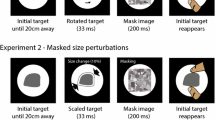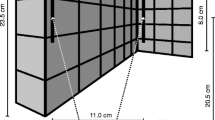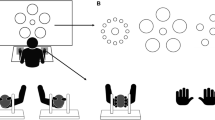Abstract
Grasp modification during prehension movements was studied in response to slight variations of somesthetic information about object size. Three experiments were carried out. In experiment 1 eight subjects were required to reach and grasp an object whose size could either increase or decrease, whereas its visual image remained unmodified. The object size was changed during the experiment with uninformed subjects after a block of trials during which visual and somesthetic information were congruent. At the end of the experiment subjects were required to reproduce the size of the object with their fingers (matching test). Results showed that maximal grip aperture during prehension as well as finger aperture in the matching test were modified according to variation in object size, although no subject realized that the object had changed during the experiment. Grasp time was also altered by object size change. Greater and earlier adaptation in maximal grip aperture, as well as perturbation of grasp time, were observed for decrease than for increase in object size. However, complete compensation was never reached for both parameters. Constant confidence in vision could have prevented both complete compensation and conscious detection of object change. This was investigated in two additional experiments. In experiment 2 visual information was made unreliable by informing subjects about variation in grasped object size. This led to greater and earlier modification in maximal grip aperture than in experiment 1. Grasp time was kept almost constant regardless of size variation. In experiment 3 vision of the stimulus was prevented and no information on change in object size was given to subjects. The results of experiment 3 were similar to those of experiment 1, although modification in maximal grip aperture was larger for increase in object size. Correspondingly, grasp time was more affected by increase than by decrease in object size. The results of the three experiments suggest that kinematic parameters usually considered as dependent on object properties, such as maximal grip aperture, were modified in order to compensate perturbation of temporal parameters. This modification induced a “pragmatic” knowledge of object size (as showed by the results of the matching test), although awareness was not reached.
Similar content being viewed by others
References
Arbib MA (1981) Perceptual structures and distributed motor control. In: Brooks VB (ed) Motor control. (Handbook of physiology, sect 1, The nervous system, vol II, part 2) Williams & Wilkins, Baltimore, pp 1449–1480
Chieffi S, Gentilucci M (1993) Coordination between the transport and the grasp components during prehension movements. Exp Brain Res 94: 471–477
Chieffi S, Fogassi L, Gallese V, Gentilucci M (1992) Prehension movements directed to approaching objects: influence of stimulus velocity on the transport and grasp components. Neuropsychologia 30: 877–897
Chieffi S, Gentilucci M, Allport A, Sasso E, Rizzolatti G (1993) Study of selective reaching and grasping in a patient with unilateral parietal lesion. Dissociated effects of residual spatial neglect. Brain 116: 1119–1137
Fitts PM (1954) The information capacity of the human motor system in controlling the amplitude of movement. J Exp Psychol 47:381–391
Gentilucci M, Castiello U, Corradini ML, Scarpa M, Umiltà C, Rizzolatti G (1991) Influence of different types of grasping on the transport component of prehension movements. Neuropsychologia 29: 361–378
Gentilucci M, Chieffi S, Scarpa M, Castiello U (1992) Temporal coupling between transport and grasp components during prehension movements: effects of visual perturbation: Behav Brain Res 47: 71–82
Gentilucci M, Toni I, Chieffi S, Pavesi G (1994) The role of proprioception in the control of prehension movements: a kinematic study in a peripherally deafferented patient and in normal subjects. Exp Brain Res 99: 483–500
Ghez C, Gordon J, Ghilardi MF, Christakos CN, Cooper SE (1990) Roles of proprioceptive input in the programming of arm trajectory. Cold Spring Harb Symp Quant Biol 55: 837–847
Goodale MA, Pelisson D, Prablanc C (1986) Large adjustments in visually guided reaching do not depend on vision of the hand or perception of target displacement. Nature 320: 748–750
Gordon M, Forssberg H, Johansson RS, Westling G (1991) Visual cues in the programming of manipulative forces during precision grip. Exp Brain Res 83: 477–482
Iberall T, Bingham G, Arbib MA (1986) Opposition space as a structuring concept for the analysis of skilled hand movements. Exp Brain Res 15: 158–173
Jakobson LS, Goodale MA (1989) Trajectories of reaches in prismatically displaced targets: evidence for “automatic” visuomotor recalibration. Exp Brain Res 78: 575–587
Jakobson LS, Goodale MA (1991) Factors affecting higher-order movement planning: a kinematic analysis of human prehension. Exp Brain Res 86: 199–208
Jeannerod M (1981) Intersegmental coordination during reaching at natural visual objects. In: Long J, Baddeley A (eds) (Attention and Performance IX) Erlbaum, Hillsdale, NJ, pp 153–169
Jeannerod M (1984) The timing of natural prehension movements. J Mot Behav 16: 235–254
Jeannerod M (1988) The neural and behavioural organization of goal-directed movements. Clarendon, Oxford
Johansson RS, Westling G (1988) Programmed and reflex actions to rapid load changes during precision grip. Exp Brain Res 71: 72–86
Johansson RS, Westling G (1990) Tactile afferent signals in the control of precision grip. In: Jeannerod M (ed) Motor representation and control. (Attention and performance XIII) Erlbaum, Hillsdale, NJ, pp 677–713
Lashley KS (1917) The accuracy of movement in the absence of excitation from the moving organ. Am J Physiol 43: 169–194
Marteniuk RG, Leavitt JL, MacKenzie CL, Athenes S (1990) Functional relationships between grasp and transport components in a prehension task. Hum Mov Sci 9: 149–176
Milner AD, Goodale MA (1993) Visual pathways to perception and action. Prog Brain Res 317–337
Redding GM, Wallace B (1992) Adaptive eye-hand coordination: implication of prism adaptation for perceptual-motor organization. In: Proteau L, Elliot D (eds) Vision and motor control. Elsevier, Amsterdam, pp 105–127
Rock I (1967) The nature of perceptual adaptation. Basic Books, New York
Rossetti Y, Koga K, Mano T (1993) Prismatic displacement of vision induces transient change in the timing of eye-head coordination. Percept Psychophys 54: 335–364
Rothwell JC, Taub MM, Day BL, Obeso JA, Thomas PK, Mardsen CD (1982) Manual motor performance in a deafferented man. Brain 105: 515–542
Sainburg RL, Poizner H, Ghez C (1993) Loss of proprioception produces deficits in interjoint coordination. J Neurophysiol 70: 2136–2147
Sanes JN, Mauritz KH, Dalakas MC, Evarts EV (1985) Motor control in humans with large-fiber sensory neuropathy. Hum Neurobiol 4: 101–114
Savelsbergh GJP, Whiting HTA, Bootsma RJ (1991) Grasping tau. J Exp Psychol 17: 315–322
Viviani P, McCollum G (1983) The relation between linear extent and velocity in drawing movements. Neuroscience 10: 211–218
Viviani P, Terzuolo C (1980) Space-time invariance in learned motor skills. In: Stelmach GE and Requin J (eds). Tutorials in motor behavior. North-Holland, Amsterdam, pp 525–533
Wallace SA, Weeks DL (1988) Temporal constraints in the control of prehensive movements. J Mot Behav 20: 81–105
Wing AM, Turton A. Fraser C (1986) Grasp size and accuracy of approach in reaching. J Mot Behav 18: 245–260
Author information
Authors and Affiliations
Rights and permissions
About this article
Cite this article
Gentilucci, M., Daprati, E., Toni, I. et al. Unconscious updating of grasp motor program. Exp Brain Res 105, 291–303 (1995). https://doi.org/10.1007/BF00240965
Received:
Accepted:
Issue Date:
DOI: https://doi.org/10.1007/BF00240965




